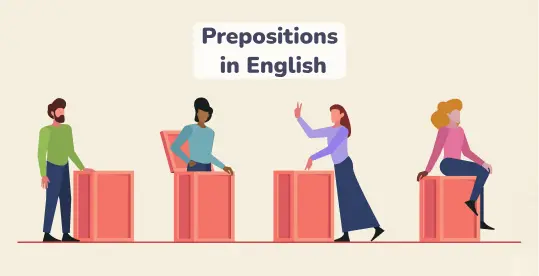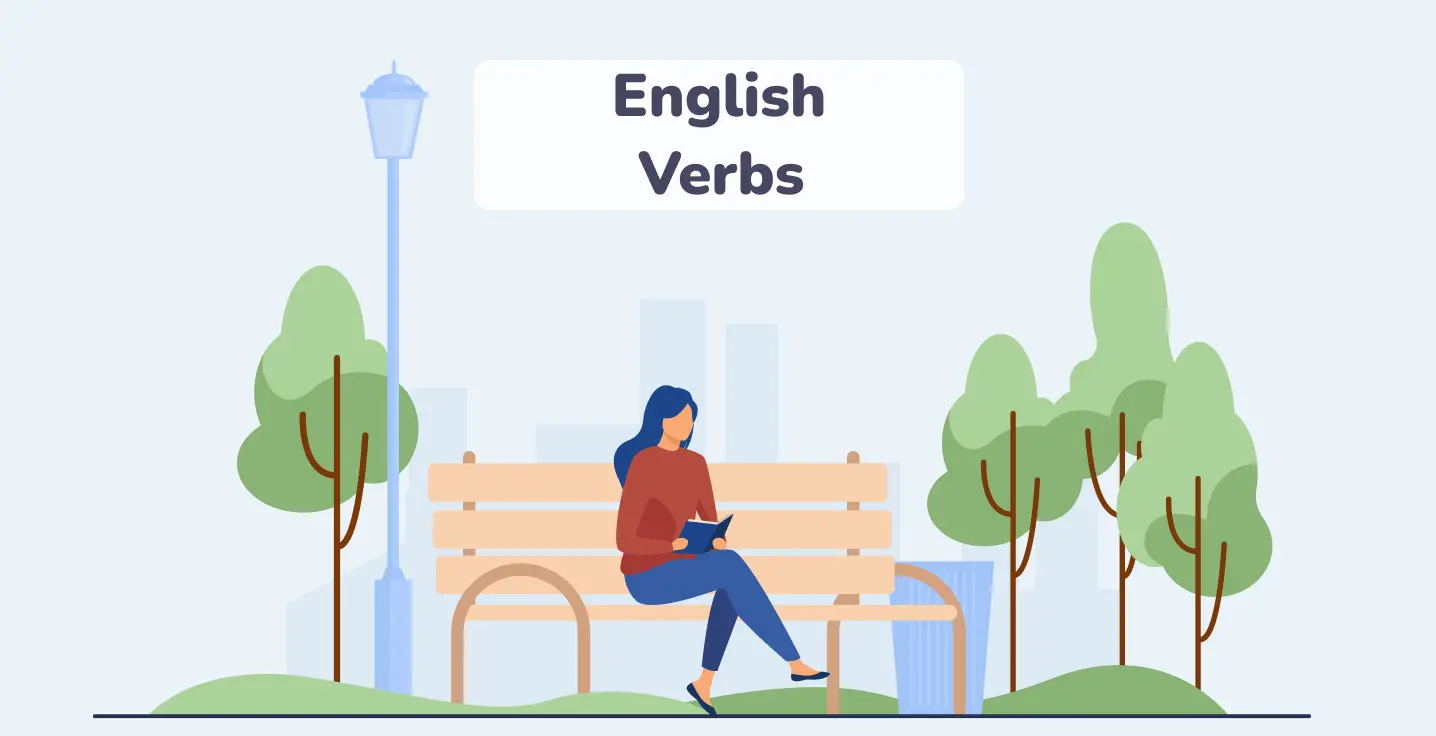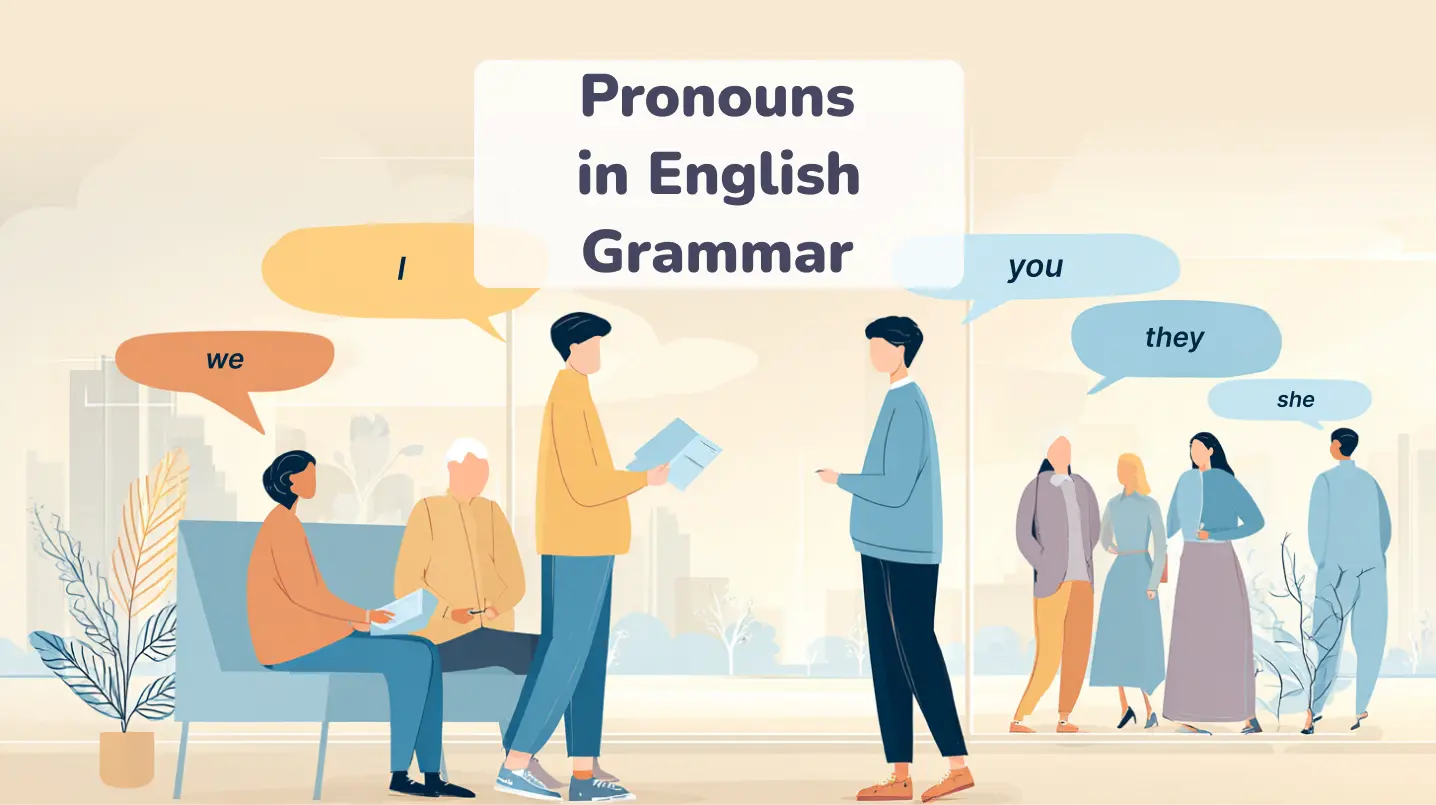What is a preposition?
Let’s start with a simple definition — prepositions are used to describe the relationships with objects in a sentence (a noun or a pronoun).
Answering the “What are prepositions?” question on a deeper level, these words bring more clarity to speech or a text as you are able to tell not only some facts or thoughts, but also describe them according to where, how, and why they happened.
This way, you make your sentences richer in detail, as telling only some general information makes it boring, and rarely will someone read or listen until the end, so prepositions are your best friends in such a situation.
Basic structure:
[Preposition] + [object]
Keep reading, and you will explore prepositions examples, colored with real-life circumstances that are common for every human. Despite your goal (we used a preposition here), you will find this information useful and interesting, developing your writing, listening, and reading skills.
Level up your English with Koto!
Types of prepositions with examples


When becoming fluent in English, you need to learn the list of common prepositions as it makes your language smooth and accurate. At the same time, you will increase your vocabulary and reading comprehension. You will study the categories of them through real-life samples, which you can find in all types of content.
Without talking a lot, let’s check the first review of all kinds of connecting words we are learning today.
Overview of preposition categories
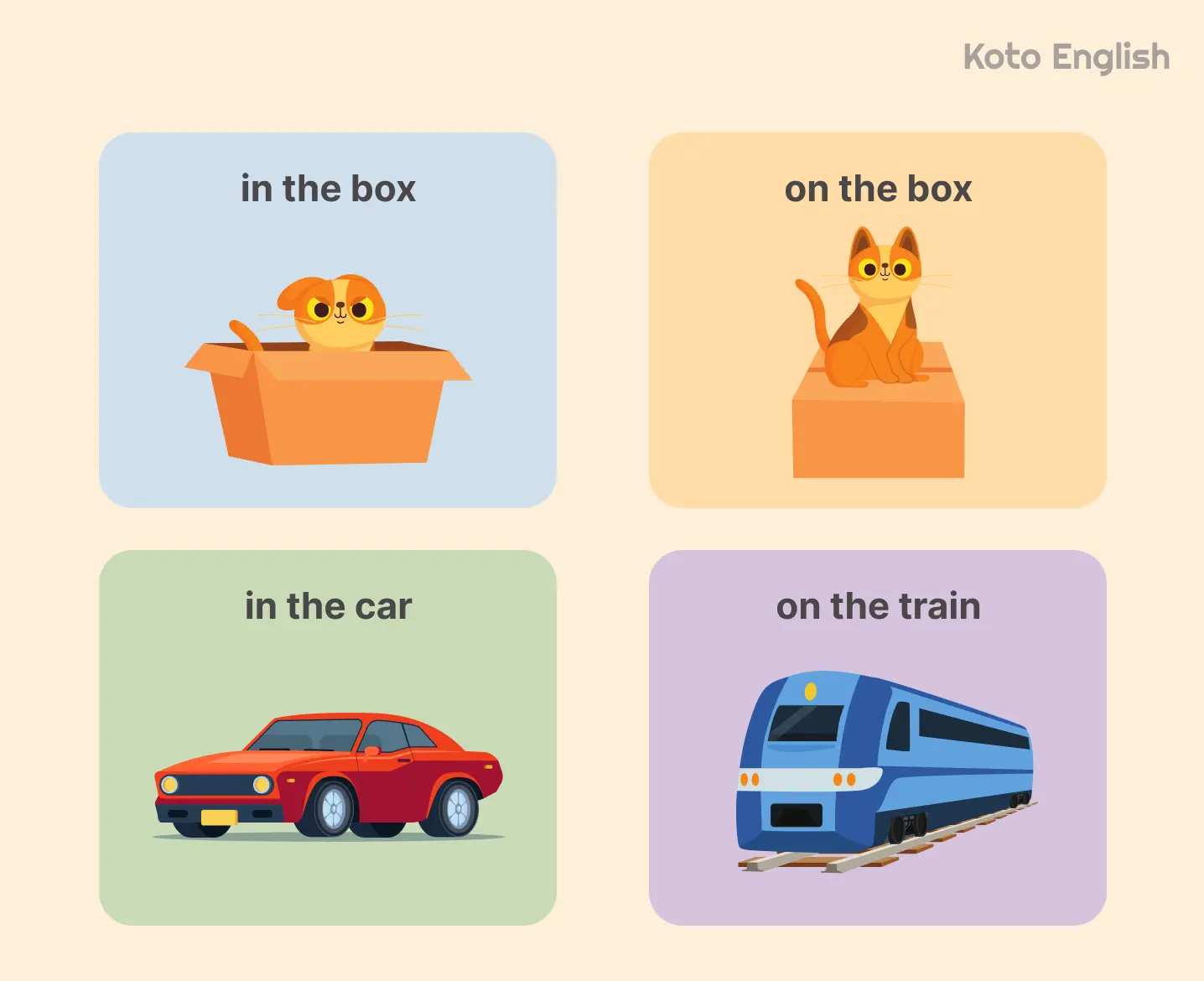
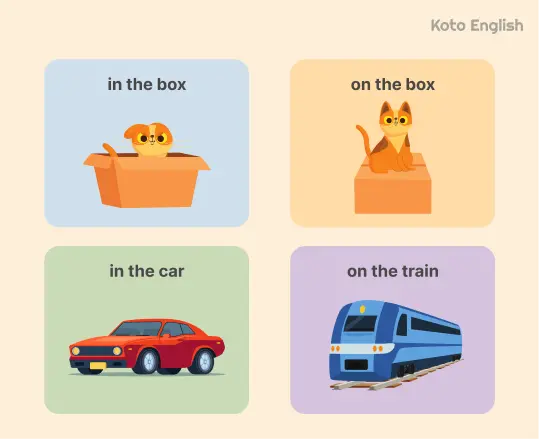
There are lots of classifications so you can get confused when trying to study all of them. Therefore, we will briefly examine an expanded list and discuss the main groups with more detail. Here is a table with examples of prepositions for more understanding:
| Type | Common words | Examples |
|---|---|---|
| Place and location | in, on, at, etc. |
Please, look
I put new fruits
|
| Direction | towards, into, onto, etc. |
I need to climb
I can’t jump
|
| Time | at, for, since, etc. |
Meet me
I have been working here
|
| Method (how?) | by, with, etc. |
Did you travel here
I made it
|
| Reason (cause) | because of, due to, for, etc. |
Our match is cancelled
The book was cancelled
|
Exploring the main groups
When learning all prepositions, you may find it tricky as there are dozens of types. Luckily for all learners, there are five core categories that are the most widely used in English nowadays.
Here, you will study not only relation words but also examples and detailed descriptions. Let’s master these lists and gain more knowledge.
| Category | Description | Example |
|---|---|---|
| Prepositions of place | Used to show the position of a thing or a human: in, on, out, above, below, behind, etc. |
I hide my laptop
You need to store it
|
| Prepositions of time | Used for a specific time or duration: at, for, until, since, etc. |
I will study
He baked it
|
| Prepositions of direction | Used for relocations: across, along, down, up, etc. |
Let’s walk
She spreads information
|
| Prepositions of cause, purpose | Give (explain) the reason for something to happen: because of, for, from, out of, etc. |
Do you know this song “
We made this art
|
| Compound and phrasal prepositions | Two or three words used as fixed phrases: according to, by means of, etc. |
We make decisions
I want to go on a date
|
Now, instead of a disconnected list of all prepositions, you can learn the core groups and make the studying process easier. As you are acknowledging about types, it is time to go ahead and learn the proper usage of the named relational words.
There are many types of prepositions, from the ones that indicate a place (in, on, at, etc.) to means and instruments (by, with, like, via, etc.), time (in, during, since, till, etc.), and more.
How to use prepositions correctly in sentences?
For now, when you have defined the preposition words and their meaning, it is time to expand your knowledge and become more familiar with the correct usage of them in sentences. In this part of the guide, you will learn how to apply these terms without effort, making your English more natural.
- Place them before the object.
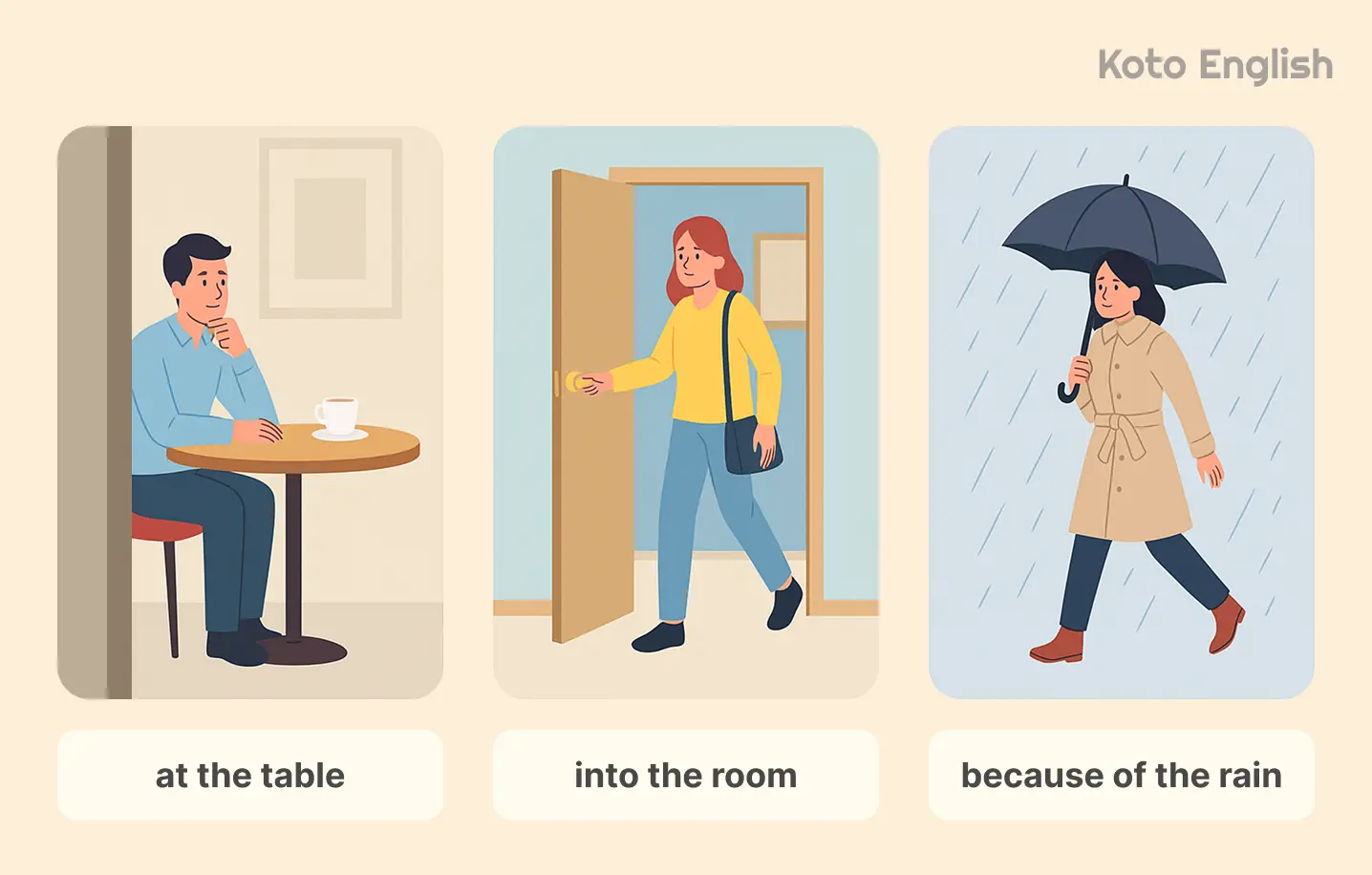
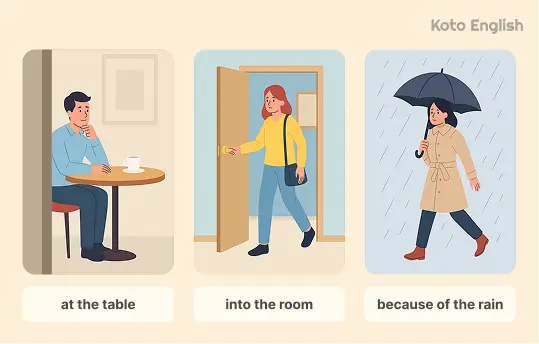
Here, you need to remember a simple tip that a chosen preposition in English has to be adjusted to a noun/pronoun/phrase (but only the one they are connected with) so that this usage is correct. Additionally, if the preposition needs to be used with a verb, you have to turn it into the -ing form.
- Avoid additional prepositions.
Sometimes, even if it seems OK to put the term, the sentence may just not need it because it is full and the context is clear. All the common prepositions are useful, but sometimes, they make your text or speech awkward and incorrect, which can impact your score at IELTS, a job interview, a class, or even a simple conversation with native speakers.
|
Where are you going at?
|
Where are you going?
|
In another popular case that suits English prepositions, learners can use extra parts for the preposition which is redundant. Here are some examples so that you can understand the concept:
|
The teacher is inside of the classroom.
|
The teacher is inside the classroom.
|
Here are some English grammar tips for you: if you have any doubts about the sentence structure, simply read it out loud. Your intuition and trained listening skills will allow you to identify the problem.
- Learn about similar prepositions.
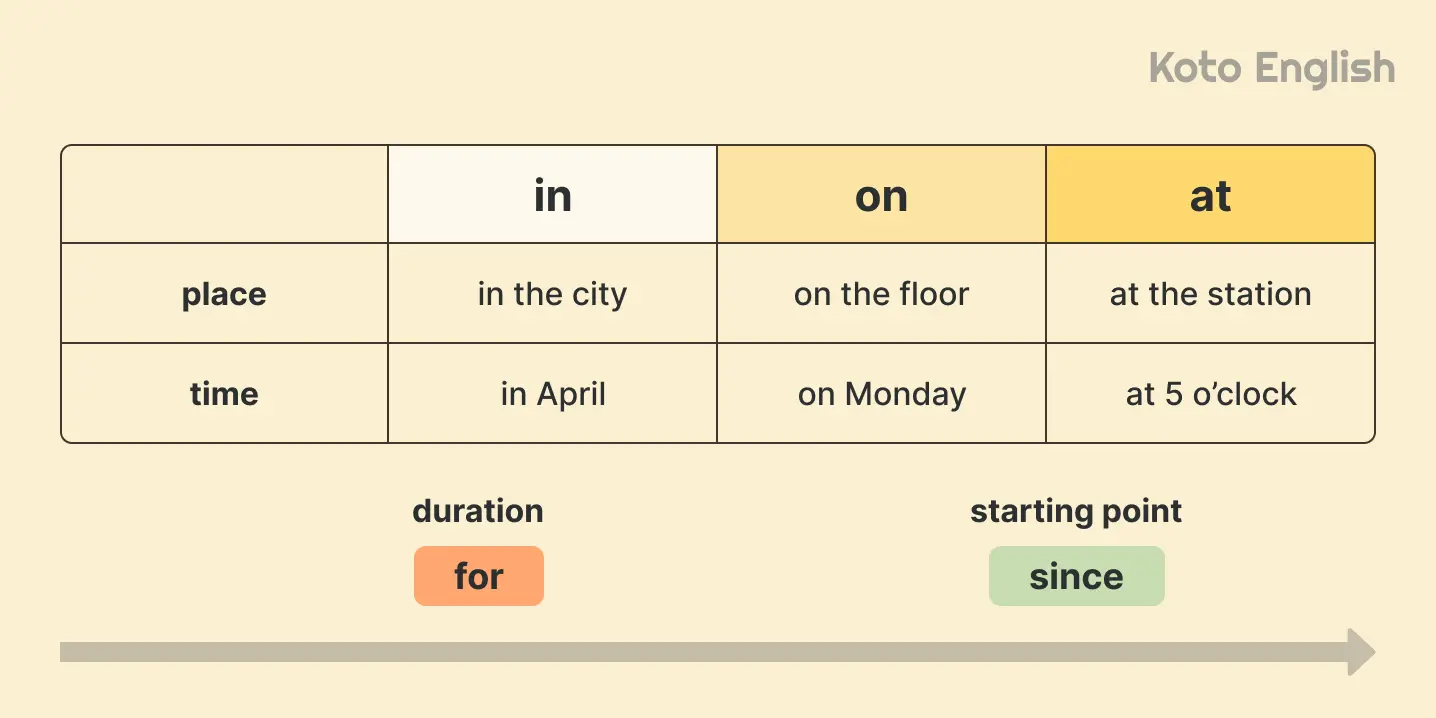
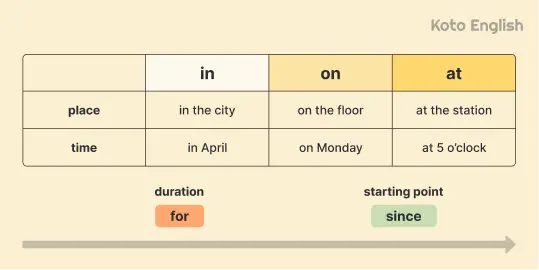
Familiar sounds and different meanings can be your enemy in this grammar topic, as they often look almost alike. It is a common challenge as to and toward seem to be equal but their usage differs.
That’s why you need to pay attention to sentences with prepositions like in and at, where the first one refers to something being inside, and the second means something is at a specific place.
Let’s showcase this nuance below:
A tip from experienced students says that you need to get a clear vision of a situation you are describing and find out if you talk about the direction, a concrete point of time/location, and so on. Listening to native speakers will also help you to remember the correct usage.
- Memorize established expressions.
Can you imagine learning English without some tricky moments? Of course not, so even learning a prepositions list means you need to familiarize yourself with some phrases that are stable, no matter what grammar says. Here is the explanation with samples:
These combinations just need to be learned as you will not find any grammar rules, still, it is easy when you are studying through the context of books, music, series, and so on.
- Adapt to English registers.
Whether you are speaking or writing in a formal, friendly, or just informal style, it is important to reflect on current state of a language as with social media involving their impact, English changes as well, allowing us to break some rules, not a preposition definition, but its placement: you can put a term at the end of a sentence in informal style.
Here are some examples:
As you can see now, these prepositions examples are flexible and widely used, so after reading this part of the guide, you are able to use all these words correctly, with no confusion.
You need to pay attention to differencens between common prepositions that can be easily mixed up, like in and at, as well as the changes in English that are caused by global involvements (social media, new language rules), and stay careful with translating some fixed phrases into English from your mother tongue.
Common mistakes
Making errors is all about developing new skills, and not about failing, as you are gaining more confidence in using the list of prepositions we outlined above. Here, you will find full information about the typical mistakes made by other learners so that you can avoid them easily.
Choosing the wrong term
These words can be complex for new students, and sometimes they may select the incorrect one when discussing locations, time, dates, and so on. The core tip here is to pay attention to the context of a sentence, as you will see below:
|
Our performance is scheduled on 5 p.m.
|
Our performance is scheduled for 5 p.m.
|
|
I am waiting in the restaurant.
|
I am waiting at the restaurant.
|
Avoiding prepositions when needed
Even studying the preposition’s meaning can make it tricky, and students can think it is unnecessary to put an additional term to a sentence, as it seems OK without it. Here, you will review how it works:
|
They made me responsible your homework.
|
They made me responsible for your homework.
|
|
I need to return this book. Wait for me library.
|
I need to return this book. Wait for me at the library.
|
Confusing “in” and “into”
They definitely sound familiar, even for some native speakers, so let’s differentiate them easily according to preposition meaning: “in” is used for the location, time, and related circumstances, while “onto” refers to the actual movement, like walking, entering, changing a position, statement, and so on.
|
She put my gaming console in the washing machine.
|
She put my gaming console into the washing machine.
|
|
Your books are into the shelf.
|
Your books are on the shelf.
|
Misplacing “for” and “since”
Another pair of prepositions looks similar, with different usage, though they both are about time. Here, in this example of common preposition mistakes, you need to remember that the point lies in the following nuances:
- for — depicts a duration of time
- since — used to point out the specific moment in the past when something started to happen
|
I have been here for 1998.
|
I have been here since 1998.
|
|
They had been painting this wall since three hours.
|
They had been painting this wall for three hours.
|
For now, you are a pro when it comes to prepositions’ definition and mistakes to avoid, so let’s move to the next part and improve your knowledge of this grammar point.
Enjoy personalized learning!
Practice Exercises
Summary of key points
After reading this article, you are a pro in using these words and embrace them to develop your grammar and become more fluent in English. You reviewed more than preposition examples, with descriptions of common types, tables for them, mistakes, and more.
Further, you need to practice with activities and improve your knowledge, which can be achieved with Koto, our learning app, and additional materials. Keep going, and we will meet you in the next lesson!
FAQ: Common questions about prepositions
The simple answer is “a lot,” but an approximate number is over 100, and around 20 of them are used daily by speakers. Is it essential to learn all of them? Not at once, but you will study them and gain more knowledge while leveling up your English level.
Above, you have found the most common examples of a preposition with real samples, and also some exercises that help you to learn the grammar.
The contrast lies in the usage as in refers to “inside” of a room, territory, age, even “yourself,” and on — for something or someone touching the front of furniture, staff, and so on. It can be used for a metaphoric case and directly as well. Let’s review what do prepositions do in samples:
Therefore, you are able to use it for almost all kinds of situations, just pay attention to the correct usage and practice daily.
Well, it depends on the situation as it is not quite OK for formal speaking, but is acceptable for informal communication with your friends or relatives. For instance, let’s say that you are having a conversation with your close colleague:
It is advisable to follow the context of a situation, define prepositions and see if it is perfectly acceptable to end a sentence with a preposition.
Actually, no, there are some cases when you can add this in front of a pronoun, so let’s focus on this moment. Typically, you will add a noun to a preposition:
However, it can be followed by a pronoun as well:
Or even a noun phrase:
As you can see, there are some nuances that you will understand deeply when practicing this grammar point.
Simply, they consist of two to three words and seem a little more complex, used for the same purposes: to point out the direction, placement, timeframe, moment of time, and so on. They are easy to make: you will use one of the words of relationship you learned above and add an adjective, a verb, or another part of speech. Here is how it works:
- in + front of: They are
in front of the bank. - on + top of: I need the book
on top of the shelf.




